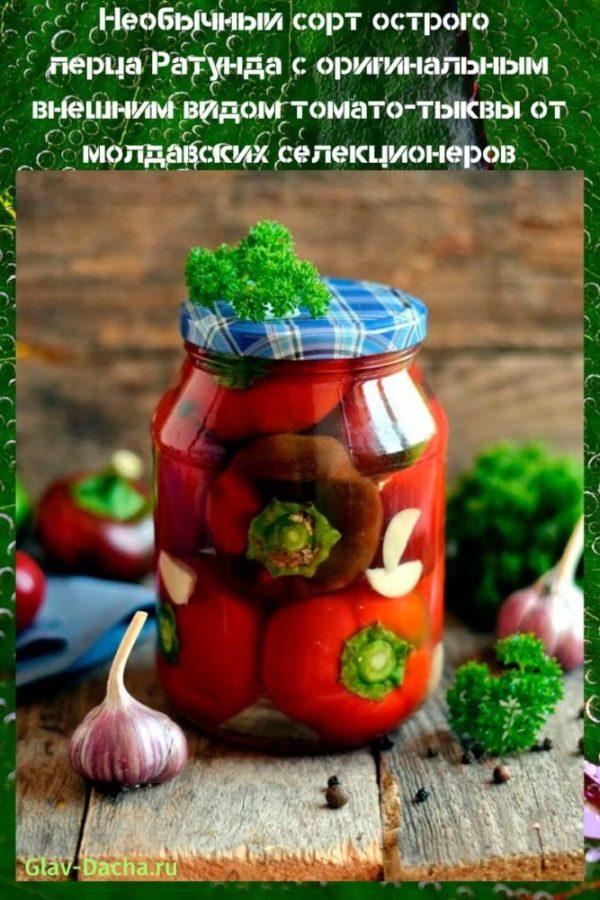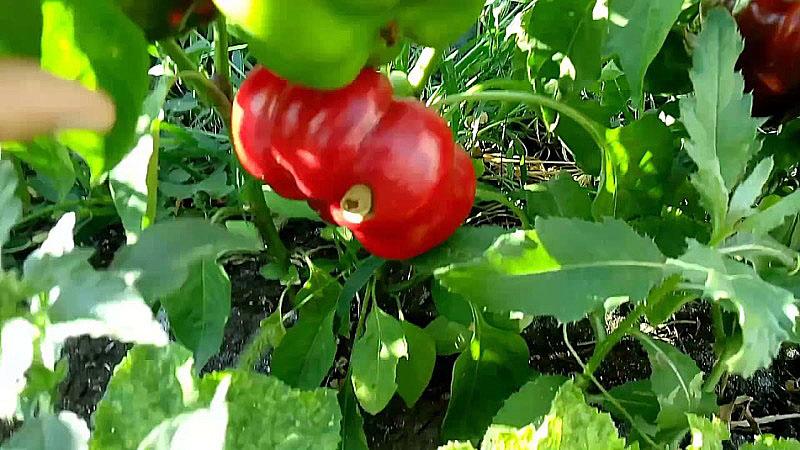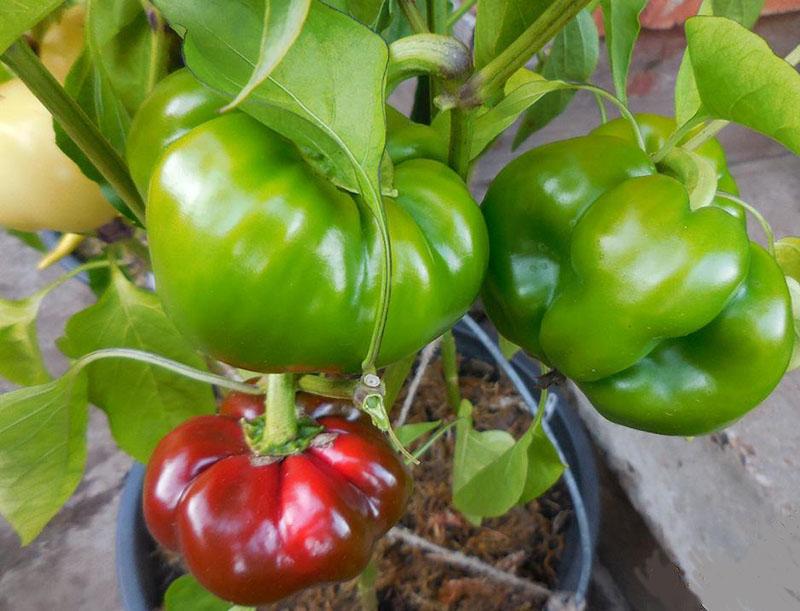An unusual variety of hot pepper Ratunda with an original appearance of tomato pumpkin from Moldovan breeders
 Breeders are constantly striving to surprise gardeners and gardeners with new varieties and hybrids of vegetables and fruits that have long been familiar. Such a masterpiece can be called Ratunda hot pepper, bred by Moldovan scientists. The fruits of this variety of pepper quickly earned the love of gardeners for their fleshy, beautiful shape, bright color and excellent taste.
Breeders are constantly striving to surprise gardeners and gardeners with new varieties and hybrids of vegetables and fruits that have long been familiar. Such a masterpiece can be called Ratunda hot pepper, bred by Moldovan scientists. The fruits of this variety of pepper quickly earned the love of gardeners for their fleshy, beautiful shape, bright color and excellent taste.
Description of Ratunda hot pepper

Hot pepper Ratunda belongs to the medium early subspecies of the Gogoshara variety. The fruits ripen in 110-115 days. The bush is undersized (its height is only 50-60 cm), semi-spreading, with medium foliage and a powerful stem, which can withstand quite large, massive fruits. Leaves are medium in size, arranged on long petioles. Flowers are located between the shoots.
 A distinctive feature of the hot Ratunda pepper is the rounded-flattened shape of the fruit. They resemble small pumpkins because of the ribbed skin delimited into slices. At the stage of technical ripeness, they have a dark green color, and at the stage of biological maturity, they become saturated red. The walls of the pods are quite dense, 6-10 mm thick. The septa have a pungent taste. The pulp is tender, juicy, with a slightly pronounced peppery aroma and a pungent pungent taste.
A distinctive feature of the hot Ratunda pepper is the rounded-flattened shape of the fruit. They resemble small pumpkins because of the ribbed skin delimited into slices. At the stage of technical ripeness, they have a dark green color, and at the stage of biological maturity, they become saturated red. The walls of the pods are quite dense, 6-10 mm thick. The septa have a pungent taste. The pulp is tender, juicy, with a slightly pronounced peppery aroma and a pungent pungent taste.
Since the variety is thermophilic, in Russian conditions it is planted in greenhouses exclusively with seedlings. For seedlings at home, seeds are sown in February-March, planted in open ground in May-June. The crop is harvested from mid-summer to early fall (all September), depending on the region of cultivation.
The variety is distinguished by abundant fruiting, due to its thick skin it perfectly tolerates transportation. Suitable for whole canning and stuffing. Each pod weighs an average of 90 to 130 grams.
Hot pepper Ratunda: growing seedlings
 Gogoshary is a product of Moldovan selection, therefore the plant is very fond of warmth, a lot of sun, fertile land, which is very much in Moldova and southern Ukraine, but much less in Russia. For growing in the middle lane of the Russian Federation, you will need greenhouse, and in the northern regions, such a pepper is very difficult to cultivate.
Gogoshary is a product of Moldovan selection, therefore the plant is very fond of warmth, a lot of sun, fertile land, which is very much in Moldova and southern Ukraine, but much less in Russia. For growing in the middle lane of the Russian Federation, you will need greenhouse, and in the northern regions, such a pepper is very difficult to cultivate.
Growing Ratunda red pepper at home begins with planting seeds for future seedlings. Seeds are disinfected in a weak solution of potassium permanganate or fungicides. Planted one at a time (maximum 2) in plastic or peat cups.
When planting seeds, it is calculated that by the time of planting in the greenhouse, the seedlings are 2 months old.
The container with the seeds is covered with glass, placed in a warm place, where the average temperature is +20. As soon as sprouts appear, the shelter is removed and the pots are rearranged closer to the light, preferably on the window sills of windows located on the south side.
Seedlings need 14 hour daylight hours, so they will need special phytolamps for supplementary lighting in conditions of lack of sunlight.
 After the appearance of 2 true leaves, the first plant feeding is carried out. In 5 liters of water, dissolve half a tablespoon of superphosphate and half a teaspoon of carbamide. Each seedling requires 100 ml of solution.
After the appearance of 2 true leaves, the first plant feeding is carried out. In 5 liters of water, dissolve half a tablespoon of superphosphate and half a teaspoon of carbamide. Each seedling requires 100 ml of solution.
If the peppers dive, then the first feeding is carried out 10 days after the transplant procedure.
 A week before the proposed transplantation into the greenhouse or into open beds, Ratunda seedlings are fed again. A teaspoon of potassium sulfate and a tablespoon of superphosphate are diluted in 5 liters of water. Each seedling requires 150 ml of solution.
A week before the proposed transplantation into the greenhouse or into open beds, Ratunda seedlings are fed again. A teaspoon of potassium sulfate and a tablespoon of superphosphate are diluted in 5 liters of water. Each seedling requires 150 ml of solution.
Transplantation and further care
 Seedlings of Ratunda are planted in May or June, depending on the growing region. Choose a site located in a sunny place, without drafts. The soil must be fertile. For Gogoshara a sharp variety, neutral or slightly alkaline soil is suitable, the pH of which is from 7 to 7.2. In the spring, even before planting seedlings, potassium-phosphate compounds are introduced into the soil in an amount of 40 g per square meter and nitrogenous fertilizers (25 g per square meter of soil). Well spicy Ratunda peppers grow after beets, cabbage, cucumbers, carrots.
Seedlings of Ratunda are planted in May or June, depending on the growing region. Choose a site located in a sunny place, without drafts. The soil must be fertile. For Gogoshara a sharp variety, neutral or slightly alkaline soil is suitable, the pH of which is from 7 to 7.2. In the spring, even before planting seedlings, potassium-phosphate compounds are introduced into the soil in an amount of 40 g per square meter and nitrogenous fertilizers (25 g per square meter of soil). Well spicy Ratunda peppers grow after beets, cabbage, cucumbers, carrots.
 Seedlings are planted so that they do not interfere with each other during the growth of the bushes.
Seedlings are planted so that they do not interfere with each other during the growth of the bushes.
Gardeners choose one of the following landing patterns:
- Four-row. They are planted in 4 rows. Dig holes every 30 cm, plant a bush in each. The width between the rows is 40 cm, between the beds 60 cm.
- Double row. They make 2 rows on the beds, dig holes every 60 cm, plant 2 bushes in the hole.
It is not necessary to use the standard planting patterns for Ratunda pepper bushes. You can come up with your own way, the main thing is that there are no more than 6 bushes per square meter of land, and the distance between the rows is more than 60 cm.
Care and harvest

After planting, Ratunda pepper needs care, feeding, watering, loosening, weeding:
- The bushes are watered with warm water for a week, under the root. Be sure to spill the aisles and paths so that the air is filled with moisture, this is useful for Gogoshar.
- After watering, the soil is carefully loosened so as not to damage the root system and mulch with straw to prevent moisture evaporation.
- Ratunda does not tolerate an arid climate, but does not like excessive moisture. Ovaries, flowers, buds fall off from a lack of moisture in peppers, yield falls, and from waterlogging, roots rot and diseases develop.
- The bushes are weeded regularly. The first time 12 days after disembarkation, then as needed.
- During the formation of buds and during fruiting, the plants are fed with a mullein solution (1 part of the fertilizer per 10 liters of water).
- When the first branch of the bush appears, pinching is carried out, removing the shoots below it.
- After the formation of paired shoots, the weak is removed, leaving the stronger one. The first "royal" flower is cut off. This promotes the active formation of new buds.
The plant belongs to the over-pollinated. If bitter, hot peppers are grown nearby, then after pollination Ratunda can become very bitter.

The top of the seedlings is thinned so that the fruits receive enough oxygen and sunlight. Weak branches, buds, flowers and fruits are promptly removed so that Ratunda does not waste energy on them.
In August, the tops of the bushes are pinched so that the plant stops growing green mass, and all its forces are directed to flowering and fruit formation.
If Ratunda is grown in a greenhouse, then during the flowering of peppers it is periodically opened for airing and at the same time helping in pollination of plants.
The crop ripens in July, fruiting continues until early September. The first fruits are picked when they are still green. This will give the plant more strength to form the next pods. The subsequent harvest is harvested every 7-10 days.
Pest and disease control
Ratunda has average resistance to pests and diseases. Most often, peppers of this species suffer from rot, fungi, slugs, aphids, Colorado potato beetle. For diseases, peppers are sprinkled with ash, chalk, sprinkled with garlic and onion infusions. Hot peppers and mustard are used for pests. Plants are treated with insecticides three times a season.
They use hot peppers Gogoshary fresh, pickled, baked, stuffed, fried. To soften the rough skin, the fruits are soaked in warm water with a little soda for a couple of hours.
Ratunda is a juicy, tasty, beautiful and unusual pepper that looks like a tomato and pumpkin at the same time. Due to the high yield of this variety, you can stock up on vitamins for the whole winter. And weak, small peppers are quite suitable for the original decoration of the room.